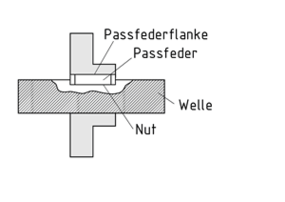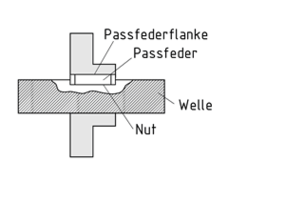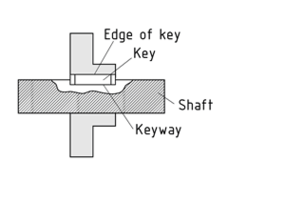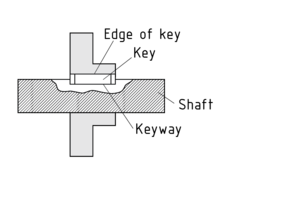
Seleccione uno
o más idiomas
0,1,3
- Alemán
- Inglés
- Chino
- Español
Conexión de chaveta

Las conexiones de chaveta son uno de los tipos de conexión bloqueada mecánicamente más comunes. Son creadas cortando un paso de chaveta tanto en el eje como en la conexión en la cual se insertará la chaveta. Cuando se inserta la chaveta, los lados del paso de chaveta y la chaveta se presionan entre sí.
Hay algo de juego entre la columna de la chaveta y la parte inferior del paso de chaveta, de manera que los torques y las fuerzas solo se transmiten mediante los bordes de la chaveta. Si se tuerce, se puede producir una distribución no pareja de la presión a lo largo de la chaveta. Para prevenir esto, la conexión no debe ser muy larga. La superposición de muesca y el desplazamiento axial deben evitarse al diseñar la chaveta para que sea un poco más corta que el paso de chaveta.
Las conexiones de chaveta son fáciles de acomodar y remover, pero no es posible mover la conexión en el eje durante la operación. A menudo son usadas como elementos de impulso.
Conexión de chaveta
Passfederverbindung

Die Passfederverbindungen gehören zu den häufigsten formschlüssigen Verbindungen. Um sie herzustellen, wird sowohl in die Welle als auch in die Nabe eine Nut gefräst, in die die Passfeder eingelegt wird. Dabei pressen sich Nut- und Passfederseitenflächen aneinander an.
Zwischen Passfederrücken und Nutgrund der Nabe ist ein Spiel vorhanden, sodass Drehmomente und Kräfte ausschließlich über die Passfederflanken übertragen werden. Bei Verdrillung kann entlang der Passfeder ungleichmäßige Pressungsverteilung auftreten. Um dies zu verhindern, darf die Nabe nicht zu lang sein. Eine Überlagerung von Kerben und ein axiales Verschieben werden vermieden, indem die Passfeder regelmäßig etwas kürzer als die Nut angelegt wird.
Passfederverbindungen sind leicht montierbar und demontierbar. Ein Verschieben der Nabe auf der Welle während des Betriebes ist jedoch nicht möglich. Sie werden oft für Mitnehmeraufgaben eingesetzt.
Key connection

Key connections are one of the most common types of mechanically locked connection. They are created by Cutting a keyway into both the Shaft and the hub, into which the key is inserted. When the key is inserted, the sides of the keyway and the key press against each together.
There is some play between the spine of the key and the bottom of the keyway, so torques and forces are only transmitted via the edges of the key. Twisting can cause uneven distribution of pressure along the key. To prevent this, the Hub must not be too long. Notch Superposition and axial displacement are avoided by designing the key to be a little shorter than the keyway.
Key connections are easy to Fit and remove, but it is not possible to move the hub on the shaft during operation. They are often used as driving elements.
键接

键连接是机械连接中最常用的类型之一。它们是通过在轴和轮毂上分别切取一个键槽,之后将键插入其中而形成的。当键被插入后键与键沟的边缘互相压紧。
在键脊和键沟底部键存在着一些缝隙,所以扭矩和力只能通过键的边缘传递。扭转会造成力沿着键不均匀地传播。为了防止这种现象的产生,轮毂不得太长。将键设计略短于键沟时可避免缺口重叠和轴向位移。
键连接易于安装和移动,但是在运行时无法移动轴上的轮毂。它们通常作为驱动元件来使用。
键连接
